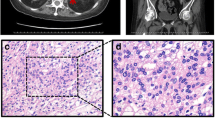Abstract
Bilateral adrenal macronodular hyperplasia (BMAH) is a rare form of Cushing’s syndrome characterised by the presence of bilateral secretory adrenal nodules and hypercortisolism. Familial studies support a genetic basis for BMAH, and the disease has been linked to mutations in ARMC5, a gene shown to have a tumour suppressor-like action in the development of adrenal nodules. This study aimed to investigate whether ARMC5 mutations play a role in the development of incidentally discovered bilateral adrenal nodules. We investigated 39 patients with incidentally discovered bilateral adrenal nodules >0.8 cm in diameter who underwent extensive biochemical testing to look for signs of subclinical hypercortisolism. Genomic DNA was analysed by Sanger sequencing, using primers targeted to ARMC5 transcripts. Of the 39 patients included in our study, three were identified as having variants in ARMC5. Two of these are unlikely to be clinically significant, but there is evidence that the third mutation, Chr16:g.31476122;c.1778G>C (p.Arg593Pro), may be pathogenic. Another variant, affecting the same amino-acid residue c.1777C>T (p.Arg593Trp), has been identified previously in two studies of BMAH patients, where it has been shown to segregate with disease in one BMAH family. This patient had biochemical evidence of hypercortisolism in the absence of overt Cushing’s syndrome, and underwent bilateral adrenalectomy separated in time. The presence of a probably clinically significant mutation in ARMC5 in one patient with bilateral adrenal incidentalomas adds to the growing body of evidence in support of ARMC5 as a critical mediator of adrenal nodule development. In addition, the absence of significant ARMC5 mutations in 38 of our patients represents an important negative finding, demonstrating the degree of variability within the pathogenesis of adrenal nodule development.
Similar content being viewed by others
References
A. Lacroix, ACTH-independent macronodular adrenal hyperplasia. Best Pract Res: Clin Endocrinol Metab 23, 245–259 (2009)
E. Louiset, C. Duparc, J. Young et al., Intraadrenal corticotropin in bilateral macronodular adrenal hyperplasia. N. Engl. J. Med. 369, 2115–2125 (2013)
J.M. Swain, C.S. Grant, R.T. Schlinkert et al., Corticotropin-independent macronodular adrenal hyperplasia: a clinicopathologic correlation. Arch. Surg. 133, 541–546 (1998)
G. Assié, R. Libé, S. Espiard et al., ARMC5 mutations in macronodular adrenal hyperplasia with Cushing’s syndrome. N. Engl. J. Med. 369, 2105–2114 (2013)
F.R. Faucz, M. Zilbermint, M.B. Lodish et al., Macronodular adrenal hyperplasia due to mutations in an armadillo repeat containing 5 (ARMC5) gene: a clinical and genetic investigation. J. Clin. Endocrinol. Metab. 99, E1113–E1119 (2014)
L. Gagliardi, A.W. Schreiber, C.N. Hahn et al., ARMC5 mutations are common in familial bilateral macronodular adrenal hyperplasia. J. Clin. Endocrinol. Metab. 99, E1784–E1792 (2014)
R.T. Kloos, M.D. Gross, I.R. Francis, M. Korobkin, B. Shapiro, Incidentally discovered adrenal masses. Endocr. Rev. 16, 460–484 (1995)
D.A. Vassiliadi, G. Ntali, E. Vicha, S. Tsagarakis, High prevalence of subclinical hypercortisolism in patients with bilateral adrenal incidentalomas: a challenge to management. Clin. Endocrinol. 74, 438–444 (2011)
R. Rossi, L. Tauchmanova, A. Luciano et al., Subclinical Cushing’s syndrome in patients with adrenal incidentaloma: clinical and biochemical features. J. Clin. Endocrinol. Metab. 85, 1440–1448 (2000)
P. Mulatero, F. Schiavi, T.A. Williams et al., ARMC5 mutation analysis in patients with primary aldosteronism and bilateral adrenal lesions. J. Hum. Hypertens. 30, 374–378 (2015)
M. Zilbermint, P. Xekouki, F.R. Faucz et al., Primary aldosteronism and ARMC5 variants. J. Clin. Endocrinol. Metab. 100, E900–E909 (2015)
A. Lacroix, N. N’Diaye, J. Tremblay, P. Hamet, Ectopic and abnormal hormone receptors in adrenal Cushing’s syndrome. Endocr. Rev. 22, 75–110 (2001)
I. Bourdeau, P. D’Amour, P. Hamet, J.M. Boutin, A. Lacroix, Aberrant membrane hormone receptors in incidentally discovered bilateral macronodular adrenal hyperplasia with subclinical Cushing’s syndrome. J. Clin. Endocrinol. Metab. 86, 5534–5540 (2001)
N. Miyamura, T. Taguchi, Y. Murata et al., Inherited adrenocorticotropin-independent macronodular adrenal hyperplasia with abnormal cortisol secretion by vasopressin and catecholamines: detection of the aberrant hormone receptors on adrenal gland. Endocrine 19, 319–325 (2002)
D. Vezzosi, D. Carter, C. Régnier et al., Familial adrenocorticotropin-independent macronodular adrenal hyperplasia with aberrant serotonin and vasopressin adrenal receptors. Eur. J. Endocrinol. 156, 21–31 (2007)
D.A. Vassiliadi, M. Tzanela, V. Tsatlidis et al., Abnormal responsiveness to dexamethasone-suppressed CRH test in patients with bilateral adrenal incidentalomas. J. Clin. Endocrinol. Metab. 100, 3478–3485 (2015)
C.A. Stratakis, S.A. Boikos, Genetics of adrenal tumors associated with Cushing’s syndrome: a new classification for bilateral adrenocortical hyperplasias. Nat. Clin. Pract. Endocrinol. Metab. 3, 748–757 (2007)
Author information
Authors and Affiliations
Corresponding author
Ethics declarations
Conflict of interest
The authors declare that they have no conflict of interest.
Additional information
Stylianos Tsagarakis and Ashley B. Grossman are to be considered as joint senior authors.
Rights and permissions
About this article
Cite this article
Emms, H., Tsirou, I., Cranston, T. et al. Do patients with incidentally discovered bilateral adrenal nodules represent an early form of ARMC5-mediated bilateral macronodular hyperplasia?. Endocrine 53, 801–808 (2016). https://doi.org/10.1007/s12020-016-0988-4
Received:
Accepted:
Published:
Issue Date:
DOI: https://doi.org/10.1007/s12020-016-0988-4




